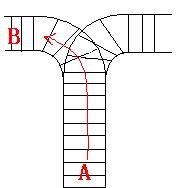HDU 1022 Train Problem I (STL 栈模拟)
Posted AC_Dreameng
tags:
篇首语:本文由小常识网(cha138.com)小编为大家整理,主要介绍了HDU 1022 Train Problem I (STL 栈模拟)相关的知识,希望对你有一定的参考价值。
Train Problem I
Time Limit: 2000/1000 MS (Java/Others) Memory Limit: 65536/32768 K (Java/Others)Total Submission(s): 30420 Accepted Submission(s): 11492
Problem Description
As the new term comes, the Ignatius Train Station is very busy nowadays. A lot of student want to get back to school by train(because the trains in the Ignatius Train Station is the fastest all over the world ^v^). But here comes a problem, there is only one
railway where all the trains stop. So all the trains come in from one side and get out from the other side. For this problem, if train A gets into the railway first, and then train B gets into the railway before train A leaves, train A can‘t leave until train
B leaves. The pictures below figure out the problem. Now the problem for you is, there are at most 9 trains in the station, all the trains has an ID(numbered from 1 to n), the trains get into the railway in an order O1, your task is to determine whether the
trains can get out in an order O2.






Input
The input contains several test cases. Each test case consists of an integer, the number of trains, and two strings, the order of the trains come in:O1, and the order of the trains leave:O2. The input is terminated by the end of file. More details in the Sample
Input.
Output
The output contains a string "No." if you can‘t exchange O2 to O1, or you should output a line contains "Yes.", and then output your way in exchanging the order(you should output "in" for a train getting into the railway, and "out" for a train getting out of
the railway). Print a line contains "FINISH" after each test case. More details in the Sample Output.
Sample Input
3 123 321 3 123 312
Sample Output
Yes. in in in out out out FINISH No. FINISHFor the first Sample Input, we let train 1 get in, then train 2 and train 3. So now train 3 is at the top of the railway, so train 3 can leave first, then train 2 and train 1. In the second Sample input, we should let train 3 leave first, so we have to let train 1 get in, then train 2 and train 3. Now we can let train 3 leave. But after that we can‘t let train 1 leave before train 2, because train 2 is at the top of the railway at the moment. So we output "No.".HintHint
Author
Ignatius.L
原题链接:http://acm.hdu.edu.cn/showproblem.php?pid=1022
题意:或者站只有一条铁轨,问火车是否可以按前面的序列进站后是否可以按后面的序列出站.
栈模拟:
AC代码:
#include<iostream> #include<stack> #define maxn 100 using namespace std; int main() { stack<char>s; int n,i,j,k; bool result[maxn];//result数组用来表示结果,1表示进栈。0表示出 char in[maxn],out[maxn];//序列1和序列2 while(cin>>n>>in>>out) { j=0,i=0,k=1; s.push(in[0]);//为防止栈空,压一个进去 result[0]=1;//记录进来了一个。 while(i<n&&j<n) { if(!s.empty()&&s.top()==out[j]) { //如果栈顶元素与序列2当前的元素相等,则弹栈,序列2集团向后移一位。 j++; s.pop(); result[k++]=0; } else { //否则从序列1中取当前元素压入栈中。 s.push(in[++i]); result[k++]=1; } } if(i==n)//如果I==N表示栈顶元素不等于序列2当前元素,且序列1中元素都已经入过栈,判断不能得到序列2一样的答案。 cout<<"No."<<endl; else { cout<<"Yes."<<endl; for(i=0; i<k; i++) if(result[i]) cout<<"in"<<endl; else cout<<"out"<<endl; } cout<<"FINISH"<<endl; } return 0; }
AC代码2:
#include <iostream>
#include <stack>
#include <cstdio>
#include <cstring>
using namespace std;
stack<int> S;
int main()
{
int n,i,j,k;
bool flag[10000];
string in,out;
while(~scanf("%d%*c",&n))
{
cin >> in >> out;
i = j = k = 0;
while(j<n+1 && i<n)
{
if(!S.empty() && S.top() == out[i])
{
i++;
flag[k] = true;
k++;
S.pop();
}
else
{
S.push(in[j]);
flag[k] = false;
j++;
k++;
}
}
cout<<k<<endl;
if(k!=2*n)
{
cout << "No." << endl;
}
else
{
cout << "Yes." << endl;
for(i = 0; i<k; i++)
{
if(flag[i])
cout << "out" << endl;
else
cout << "in" << endl;
}
}
cout << "FINISH" << endl;
}
return 0;
}
AC代码3:C语言模拟:
# include<stdio.h>
# include<string.h>
int main()
{
int n,i,j,k,head;
char a[1000],b[1000],t[1000],str[1000][10];
while(scanf("%d%s%s",&n,a,b)!=EOF)
{
head=i=j=k=0;
strcpy(str[k++],"in");
while(i<n)
{
t[head]=a[i];
while(t[head]==b[j]&&b[j]!='\0'&&t[head]!='\0')
{
head--;
j++;
strcpy(str[k++],"out");
}
head++;
strcpy(str[k++],"in");
i++;
}
if(head==0)
{
printf("Yes.\n");
for(i=0; i<k-1; i++)
printf("%s\n",str[i]);
printf("FINISH\n");
}
else
{
printf("No.\n");
printf("FINISH\n");
}
}
return 0;
}以上是关于HDU 1022 Train Problem I (STL 栈模拟)的主要内容,如果未能解决你的问题,请参考以下文章